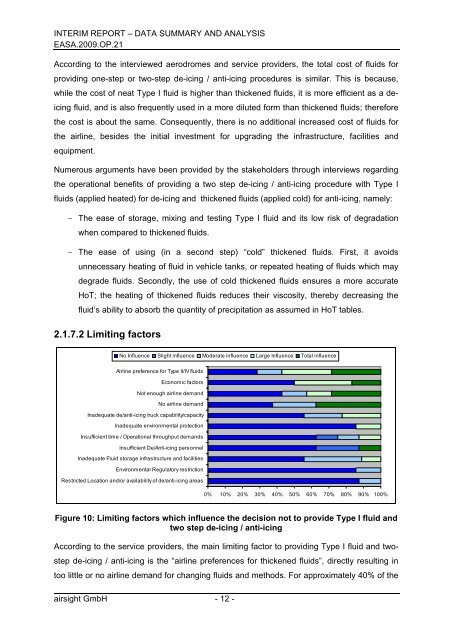Interim Report - Introduction - EASA
Interim Report - Introduction - EASA
Interim Report - Introduction - EASA
You also want an ePaper? Increase the reach of your titles
YUMPU automatically turns print PDFs into web optimized ePapers that Google loves.
INTERIM REPORT – DATA SUMMARY AND ANALYSIS<br />
<strong>EASA</strong>.2009.OP.21<br />
According to the interviewed aerodromes and service providers, the total cost of fluids for<br />
providing one-step or two-step de-icing / anti-icing procedures is similar. This is because,<br />
while the cost of neat Type I fluid is higher than thickened fluids, it is more efficient as a deicing<br />
fluid, and is also frequently used in a more diluted form than thickened fluids; therefore<br />
the cost is about the same. Consequently, there is no additional increased cost of fluids for<br />
the airline, besides the initial investment for upgrading the infrastructure, facilities and<br />
equipment.<br />
Numerous arguments have been provided by the stakeholders through interviews regarding<br />
the operational benefits of providing a two step de-icing / anti-icing procedure with Type I<br />
fluids (applied heated) for de-icing and thickened fluids (applied cold) for anti-icing, namely:<br />
− The ease of storage, mixing and testing Type I fluid and its low risk of degradation<br />
when compared to thickened fluids.<br />
− The ease of using (in a second step) “cold” thickened fluids. First, it avoids<br />
unnecessary heating of fluid in vehicle tanks, or repeated heating of fluids which may<br />
degrade fluids. Secondly, the use of cold thickened fluids ensures a more accurate<br />
HoT; the heating of thickened fluids reduces their viscosity, thereby decreasing the<br />
fluid’s ability to absorb the quantity of precipitation as assumed in HoT tables.<br />
2.1.7.2 Limiting factors<br />
No Influence Slight influence Moderate influence Large Influence Total influence<br />
Airline preference for Type II/IV fluids<br />
Economic factors<br />
Not enough airline demand<br />
No airline demand<br />
Inadequate de/anti-icing truck capability/capacity<br />
Inadequate environmental protection<br />
Insufficient time / Operational throughput demands<br />
Insufficient De/Anti-icing personnel<br />
Inadequate Fluid storage infrastructure and facilities<br />
Environmental Regulatory restriction<br />
Restricted Location and/or availability of de/anti-icing areas<br />
airsight GmbH - 12 -<br />
0% 10% 20% 30% 40% 50% 60% 70% 80% 90% 100%<br />
Figure 10: Limiting factors which influence the decision not to provide Type I fluid and<br />
two step de-icing / anti-icing<br />
According to the service providers, the main limiting factor to providing Type I fluid and twostep<br />
de-icing / anti-icing is the “airline preferences for thickened fluids”, directly resulting in<br />
too little or no airline demand for changing fluids and methods. For approximately 40% of the

















